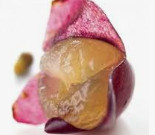Effects of drying methods on bioactive substances in grape peel residue

Using the Cabernet Sauvignon grape skin residue (skin, seed and skin-seed mixture) separated at the end of wine-making as raw materials, the skin-seed mixture, skin and seed were ground and sifted by 40 meshes respectively by five drying methods: natural drying, hot air drying at 45 degrees, hot air drying at 40 degrees, microwave drying and freeze drying. The effects of drying methods on proanthocyanidins content, DPPH free radical scavenging capacity and dietary fiber content of grape peel dregs were investigated.
The results showed that the drying speed of grape peel residue treated by different drying methods was in the order of Microwave Drying Equipment > 45 hot air drying > 40 hot air drying > natural drying > freeze drying. The DPPH free radical scavenging rate of grape peel dregs treated by hot air drying was the highest and that of natural drying was the lowest. There was a significant correlation between DPPH free radical scavenging ability and proanthocyanidin content. Except microwave drying, there was no significant difference in the effect of drying methods on dietary fiber content.
Key words: microwave drying of grape peel residue; drying method; proanthocyanidins; dietary fiber; antioxidant activity

Grapes are one of the most abundant fruits in the world. About 70% of the world's grapes are used to make wine, and the rest are used for fresh food, juice and other products. The remaining stalks, skins and seeds in grape production and brewing are collectively called grape skins residue. In recent years, with the development of grape cultivation and processing industry, more and more grape skins are produced. If not handled in time, it not only pollutes the environment, but also wastes a lot of resources.
Grape peel residue is rich in nutrients, such as protein, tartaric acid, malic acid, phenolic substances and dietary fiber, which are very beneficial to human body. The use of grape peel residue started earlier in foreign countries. Many years ago, grape peel residue was used to produce cosmetics, health products, food and so on. In some major wine producing countries, such as France, the utilization rate of grape peel residue can reach more than 70%.
In China, the use of grape peel residue started relatively late. Before that, most of the grape peel residue was thrown away as garbage or treated as feed, which was extremely wasteful. In recent years, with the development of science and technology and the gradual scarcity of resources, people pay more and more attention to the utilization of grape peel residue. Grape pomace can be used to produce grape seed oil, extract tartaric acid, polyphenols, natural pigments, dietary fiber and pectin, etc., and can also be used to produce grape seed mask, grape ultra micro powder and so on.
Fresh grape peel residue is rich in water and nutrients. It is easy to spoil if it is not dried in time. Drying treatment can quickly dehydrate the skin residue, avoid microbial contamination, reduce nutrient losses, and is conducive to the storage of the skin residue. Drying is a very important link in the food industry. It can improve food flavor, sterilize and extend the shelf life. The common methods of food drying are osmotic drying, convective drying, microwave drying, freeze drying and vacuum drying. At present, the drying method commonly used in the treatment of leather residue in distilleries is the most primitive natural drying, which not only takes a long time, but also is easy to be polluted by microorganisms.
The purpose of the experiment was to study the effects of different drying methods on proanthocyanidins content, antioxidant activity and dietary fiber content of Cabernet Sauvignon grape peel residue, in order to find a suitable drying method for rapid dehydration and drying of grape peel residue, which is conducive to the storage of grape peel residue, provide sufficient raw materials for the research and utilization of grape peel residue, and improve the utilization efficiency of grape peel resid